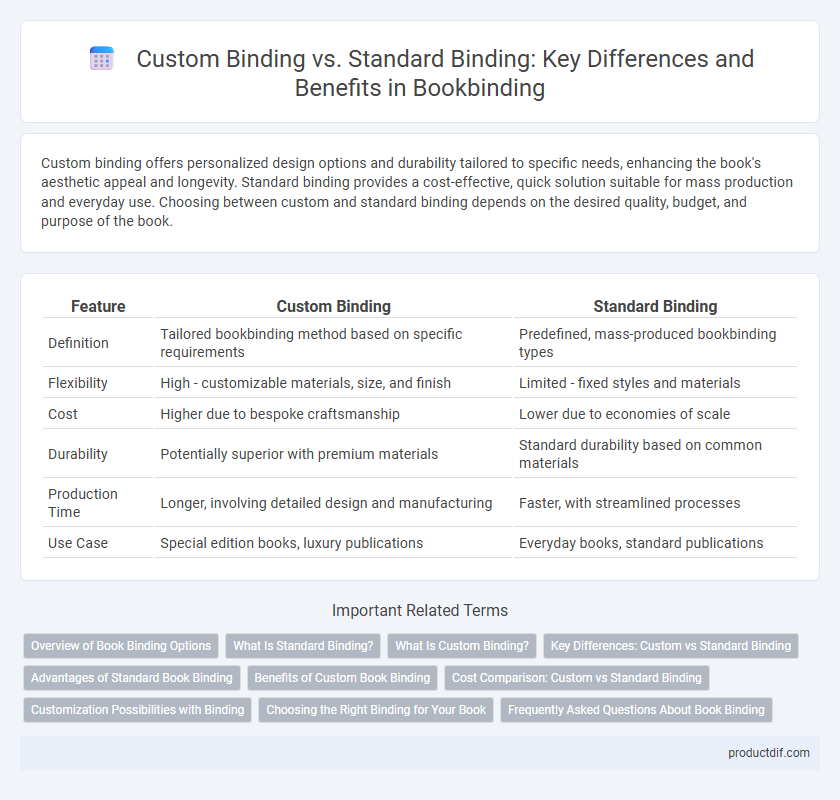Custom binding offers personalized design options and durability tailored to specific needs, enhancing the book's aesthetic appeal and longevity. Standard binding provides a cost-effective, quick solution suitable for mass production and everyday use. Choosing between custom and standard binding depends on the desired quality, budget, and purpose of the book.
Table of Comparison
| Feature | Custom Binding | Standard Binding |
|---|---|---|
| Definition | Tailored bookbinding method based on specific requirements | Predefined, mass-produced bookbinding types |
| Flexibility | High - customizable materials, size, and finish | Limited - fixed styles and materials |
| Cost | Higher due to bespoke craftsmanship | Lower due to economies of scale |
| Durability | Potentially superior with premium materials | Standard durability based on common materials |
| Production Time | Longer, involving detailed design and manufacturing | Faster, with streamlined processes |
| Use Case | Special edition books, luxury publications | Everyday books, standard publications |
Overview of Book Binding Options
Custom binding offers personalized materials, designs, and finishes that enhance a book's aesthetic and durability, often selected for limited edition or high-value publications. Standard binding includes common methods such as perfect binding, saddle stitching, and case binding, providing cost-effective and efficient solutions for mass production. Choosing between custom and standard binding depends on budget, intended use, and the desired balance between appearance and functionality.
What Is Standard Binding?
Standard binding refers to the most common method of assembling books, where pages are securely glued or stitched together along the spine, creating a durable and cost-effective product. This type of binding typically uses perfect binding, saddle stitching, or case binding, each offering varying levels of strength and flexibility depending on the book's purpose. Standard binding is widely used in mass-produced books such as novels, textbooks, and magazines due to its balance of durability and production efficiency.
What Is Custom Binding?
Custom binding refers to the process of creating personalized book covers and binding styles tailored to specific design preferences, materials, and functional requirements. It allows for unique aesthetics and enhanced durability by utilizing specialized techniques such as leather wrapping, embossed covers, and custom endpapers. Custom binding is preferred for limited editions, collectors' items, and high-quality publications where standard binding methods may not meet the desired appearance or longevity.
Key Differences: Custom vs Standard Binding
Custom binding offers tailored designs, materials, and finishes that enhance durability and aesthetics, while standard binding uses mass-produced methods focused on cost-efficiency and functionality. Custom binding often incorporates specialty stitching, embossing, or unique cover materials, whereas standard binding typically relies on common glue or saddle-stitch techniques. The choice impacts book longevity, visual appeal, and overall production cost, with custom binding suited for premium editions and standard binding ideal for high-volume printing.
Advantages of Standard Book Binding
Standard book binding offers enhanced durability and cost-effectiveness, making it ideal for mass production and widespread distribution. It ensures consistent quality with strong adherence of pages, reducing the risk of pages falling out over time. This method also supports a variety of cover materials, providing flexibility in design while maintaining structural integrity.
Benefits of Custom Book Binding
Custom book binding offers enhanced durability and personalized design options that standard binding cannot match. It allows for tailored materials, unique cover finishes, and specialized sizing to meet specific aesthetic and functional requirements. This creates a premium, professional appearance and ensures the book's longevity in various handling conditions.
Cost Comparison: Custom vs Standard Binding
Custom binding typically incurs higher costs due to specialized materials, personalized design, and lower production volumes, making it ideal for limited editions or unique projects. Standard binding offers cost efficiency through mass production and uniform processes, significantly reducing price per unit for large print runs. Businesses often balance these expenses by choosing custom binding for premium products and standard binding for cost-sensitive or high-volume needs.
Customization Possibilities with Binding
Custom binding offers extensive customization possibilities such as unique cover materials, personalized embossing, and tailored page layouts, enhancing the book's aesthetic and durability. Standard binding typically relies on preset sizes and finishes, limiting personalization options but ensuring consistency and cost-efficiency. Choosing custom binding allows authors and publishers to create distinctive, branded products that reflect their creative vision and target audience preferences.
Choosing the Right Binding for Your Book
Custom binding offers personalized materials and finishes that enhance a book's durability and aesthetic appeal, making it ideal for special editions or unique projects. Standard binding methods such as perfect binding, saddle stitching, or spiral binding provide cost-effective and efficient options suited for mass production or everyday use. Evaluating factors like budget, book type, anticipated usage, and presentation goals ensures the selection of the most appropriate binding method for your specific publishing needs.
Frequently Asked Questions About Book Binding
Custom binding offers personalized options such as unique cover materials, sizes, and finishes tailored to individual preferences, while standard binding encompasses common methods like perfect binding, saddle stitching, and spiral binding used for mass production. Customers frequently ask about durability differences, cost variations, and turnaround times between custom and standard binding options. Choosing the appropriate binding method depends on the book's purpose, desired aesthetic, and budget constraints.
Custom Binding vs Standard Binding Infographic

 productdif.com
productdif.com